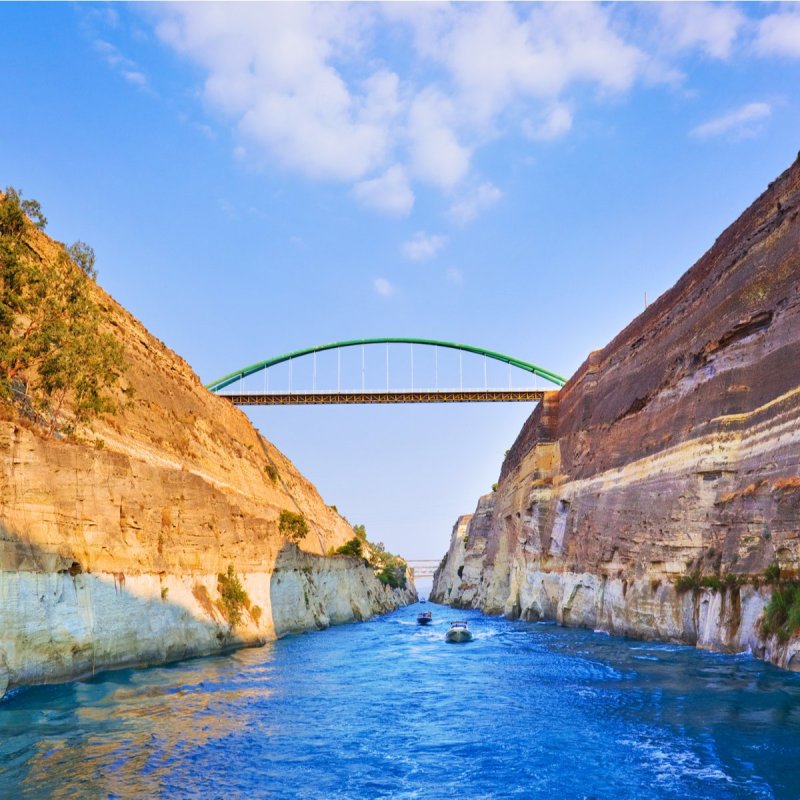
It’s not every day that you can travel through thousands of years of history in a single day, with four stops along the way, one more awesome than the next. My journey starts in Athens, then leads along the coast to the Canal of Corinth, Nafplio, and Mycenae and ends in Epidaurus. Normally, I’m not a great fan of guided bus tours, but this one was ideal. Comfortable, air-conditioned coaches, a guide who was a history student and knew his stuff, a stop for a delicious meal of Mousaka and Greek salad, and the chance to knock back a glass of Retsina wine or Ouzo because you didn’t need to worry about driving. It’s a long day trip because you also have to return. That’s why I did the stretch from Athens to Nafplio (85 miles) again on another day because there was not enough time to explore this beautiful city, the former capital of Greece. In addition, I wanted to take a short cruise of the Canal of Corinth. You just have to see this awesome structure from above and also from below.
Videos by TravelAwaits
If you visit Athens in the summer, it’s very hot, so it’s a relief to get out of the city on the way to Nafplio which leads along the Saronic Gulf and the affluent suburbs of Athens with a few impressive mansions to admire as well as a few tiny islands floating in the Gulf. In short, this a trip you will adore (plus booking information below).
Canal Of Corinth
The Canal of Corinth (seen above), which cuts through the Isthmus of Corinth and connects the Ionian Sea with the Aegean Sea, is the first stop of the day trip, at a distance of approximately 43 miles from Athens. Road signs announce the proximity of the canal which is just as well because it’s so narrow, blink your eyes and you might miss it altogether as you go over the bridge. I was actually imagining something along the lines of the Panama Canal, a misapprehension. The canal, which was opened in 1893 and after serious damage in WWII reopened for shallow traffic in 1948, is four miles long and only 70 feet wide at its base. The coach stops once it has crossed the bridge, and you can walk back on foot and glance down the steep limestone cliffs that form the walls, with just an occasional tree clinging to the sides. Looking down it’s hard to believe that any ship at all can pass through the narrow gap, but you might actually see a tourist boat floating down below. The canal never took off as the commercial venture it was intended to be and is today mostly a tourist attraction — but a memorable one you should not miss.

Nafplio
About an hour further on, you come to the second stop of the day trip: Nafplio. Located on the Peloponnese on the shore of the Argolic Gulf, this beautiful town, full of history, was the capital of Greece until 1834. Just note that the name Nafplio has several different spellings in English.

Inka Piegsa Quischotte
Arriving in the city, you are greeted by the sight of no less than three imposing castles, all bearing witness to the area’s colorful past. They are Akronafplia Castle, which dates from antiquity and was expanded and fortified by the Byzantines, Franks, Venetians, and Ottomans who all, at one time, ruled in Nafplio. The Venetians also built Bourtzi Castle on a small islet just off shore and Palamidi up on the hill, reached by over more than 900 steps. To see them all you need more time than the coach trip allows — that’s why I returned on another day.
The pretty, sheltered port is full of boats and yachts of all sizes. Stroll along the promenade. Explore the old town full of bougainvillea shaded narrow streets and ancient houses. Watch out for shops selling kombolois, the Greek worry beads. There is even an entire museum dedicated to them. For a dip in the sea, head to the sandy cove of Karathona Beach. We only had time for a walk around the port and a delicious lunch of squid, mousaka, and Greek salad in one of the many tavernas. Or if you want something more elegant, try Savouras, reportedly the best fish restaurant in town. Try your luck without a reservation; otherwise, the tour has made arrangements elsewhere.

Inka Piegsa Quischotte
Mycenae
Fortified by our meal, we headed for Mycenae, home of the legendary King Agamemnon, leader of the Greeks in the Trojan War. Mycenae was the first advanced civilization in Greece, in the late Bronze Age between 1600 and 1100 B.C. It gave name to an entire culture including script, engineering, and art.

Inka Piegsa Quischotte
Enter the massive walls of Mycenae through the Lion Gate, then proceed to the most famous landmark, the vaulted Treasury of Atreus, probably the tomb of Agamemnon. The Myceneans buried their noble dead with golden face masks and armor and the women with lavish clothing and gold jewelry. Visit the small but interesting archaeological museum, which exhibits many of the finds from the surrounding tombs and graves, but know that the mask of Agamemnon you’ll see here is a reproduction, the original being in the National Museum of Athens.
A modern village also called Mycenae is nearby. Here, you can get refreshments, which are much needed because, except in the tombs, there is no shade in Mycenae, and you have a lot of walking and climbing to do on uneven surfaces.

Epidaurus
Located in a richly wooded valley, many consider Epidaurus the origin of modern medicine. Around 2000 B.C., it started with a sanctuary dedicated to the God of Healing, Asclepius. Holy men guarded the sanctuary, which consisted of a hospital, accommodation for pilgrims, banquet hall, and temple. Sick people in the ancient world often traveled far distances to be healed by the powers of the gods, practicing religious rituals. Over time, the holy men started to use herbs and plants collected from the surrounding woods to develop treatments that became the basis of medicine in the ancient world. The sanctuary as you can see it today still features the foundations of the hospital and several columns of the temple.

Inka Piegsa Quischotte
Next to it rises the world-famous amphitheater, a venue for drama and performances like no other in the world. It dates back to the fourth century B.C. The theatre rose 34 tiers with a round platform for the performers and the capacity to seat 15,000 people. What makes this amphitheater so special is its acoustics. Even words whispered on the stage could be heard in the uppermost tier of seats. I got to witness this incredible acoustic phenomenon myself when a visitor, standing on the stage, spontaneously burst into singing an opera aria. I happened to stand at the top tier and her voice came up crystal clear. There is also a second, smaller theater nearby.
The amphitheater is still in use today. A festival has been held every summer since 1954 with the performance of ancient and modern plays by Greek and foreign artists.
Despite being so heavily visited during the festival and as a popular tourist destination, the facilities are rather poor. I couldn’t even find a kiosk to buy a bottle of water. Maybe it has improved, but just in case, bring drinks and a snack. The return trip brings you back to Athens in the late evening.
Pro Tips
I did this one-day coach trip (which can be booked here) to get an overview of the sites I always wanted to see. Be aware that a lot of walking and sometimes steep climbing (in Nafplio and around the theatre in Epidaurus) is involved, so wear good walking shoes. Otherwise, you could easily slip. Given the distances between the stops and the number of interesting things to do and see at each, you may consider doing this in one or even three days if you have the time. Tours are available separately to each destination.
For a cruise along the Canal of Corinth, plan a full day and consider one of these mini cruises, which I greatly enjoyed. The view from the bottom of the canal is as stunning as it is from above.
Editor’s Note: The route shown in the map above is not necessarily the route followed during the bus tour Inka recommends. Rather, we share it to give you an idea of where these towns and sites are located.
For more in-and-around-Athens inspiration, consider 7 Incredible Boutique Hotels In Athens, Greece, Eating Local In Athens, Greece: The Best Food To Try, and The Acropolis Vs. Temple Of Poseidon In Greece: 7 Key Differences.
